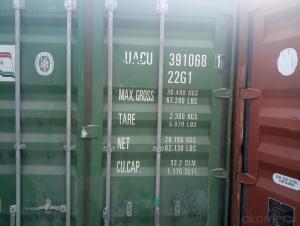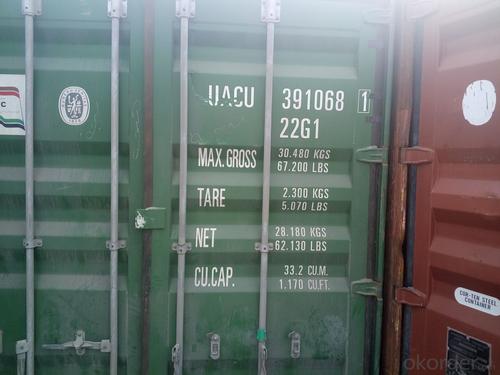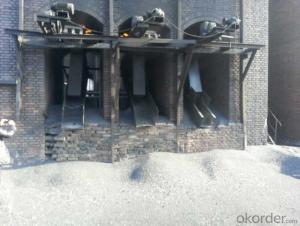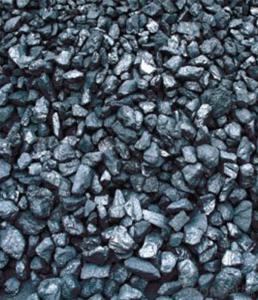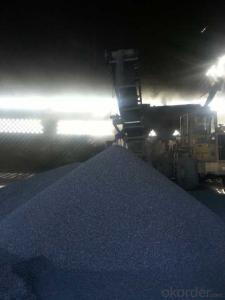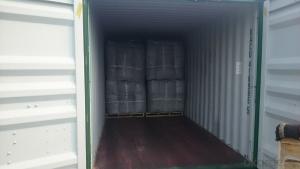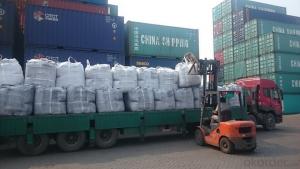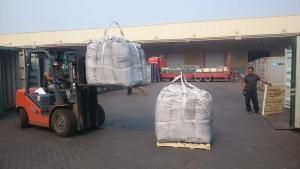Used in EAF as Charge Coke for Steel Plants with Ash 6%max
- Loading Port:
- Tianjin
- Payment Terms:
- TT OR LC
- Min Order Qty:
- 21 m.t.
- Supply Capability:
- 6000 m.t./month
OKorder Service Pledge
OKorder Financial Service
You Might Also Like
Introduction:
Calcined anthracite can be called carbon additive, carbon raiser, recarburizer, injection coke, charging coke, gas calcined anthracite.
Carbon Additive/Calcined Anthracite Coal may substitute massively refinery coke or graphite. Meanwhile its cost is much less than the refinery coke and graphite. Carbon Additive is mainly used in electric steel ovens, water filtering, rust removal in shipbuilding and production of carbon material.
It has good characteristics with low ash, low resistivity, low sulphur, high carbon and high density. It is the best material for high quality carbon products. It is used as carbon additive in steel industry or fuel.
Features:
Best quality Taixi anthracite as raw materials through high temperature calcined at 800-1200 ℃ by the DC electric calciner with results in eliminating the moisture and volatile matter from Anthracite efficiently, improving the density and the electric conductivity and strengthening the mechanical strength and anti-oxidation, It has good characteristics with low ash, low resistivity, low carbon and high density. It is the best material for high quality carbon products, it is used as carbon additive in steel industry or fuel.
Specifications:
F.C.% | 95MIN | 94MIN | 93MIN | 92MIN | 90MIN | 85MIN | 84MIN |
ASH % | 4MAX | 5MAX | 6 MAX | 6.5MAX | 8.5MAX | 12MAX | 13MAX |
V.M.% | 1 MAX | 1MAX | 1.0MAX | 1.5MAX | 1.5MAX | 3 MAX | 3 MAX |
SULFUR % | 0.3MAX | 0.3MAX | 0.3MAX | 0.35MAX | 0.35MAX | 0.5MAX | 0.5MAX |
MOISTURE % | 0.5MAX | 0.5MAX | 0.5MAX | 0.5MAX | 0.5MAX | 1MAX | 1MAX |
Pictures

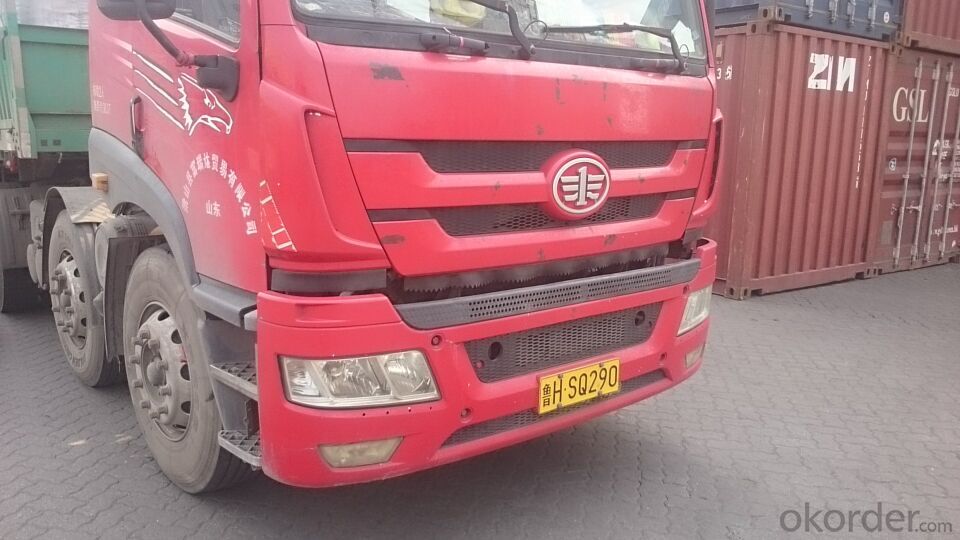


FAQ:
Packing:
(1). Waterproof jumbo bags: 800kgs~1100kgs/ bag according to different grain sizes;
(2). Waterproof PP woven bags / Paper bags: 5kg / 7.5kg / 12.5kg / 20kg / 25kg / 30kg / 50kg small bags;
(3). Small bags into jumbo bags: waterproof PP woven bags / paper bags in 800kg ~1100kg jumbo bags.
Payment terms
20% down payment and 80% against copy of B/L.
Workable LC at sight,
- Q: How does carbon impact the structure and function of ecosystems?
- Carbon, as a fundamental element, plays a crucial role in shaping the structure and function of ecosystems. It serves as a building block of life, found in all living organisms, and continuously cycles between the atmosphere, living organisms, and the Earth's surface. The impact of carbon on ecosystems is diverse, both directly and indirectly. To begin with, carbon is a vital component of organic matter, including plants, animals, and decomposing organic materials. It provides the necessary energy and nutrients for the growth and development of organisms. Through the process of photosynthesis, plants absorb carbon dioxide from the atmosphere and convert it into organic compounds, primarily carbohydrates. These compounds serve as a source of energy and building materials for other organisms, forming the basis of the food chain. As a result, carbon is essential for sustaining the productivity and biodiversity of organisms within ecosystems, as it contributes to their structure and functioning. Additionally, carbon influences the physical structure of ecosystems. In terrestrial ecosystems, carbon is stored in vegetation and soils, creating carbon sinks. Forests, for example, store significant amounts of carbon in their biomass and soils. This plays a crucial role in mitigating climate change by absorbing and sequestering carbon dioxide. However, the loss of these ecosystems, due to deforestation or degradation, can release large amounts of carbon back into the atmosphere. This contributes to the greenhouse effect and climate change. In marine ecosystems, carbon is stored in the form of dissolved inorganic carbon, which can affect ocean acidity. The increasing concentration of carbon dioxide in the atmosphere leads to ocean acidification, impacting the growth and survival of marine organisms, particularly those with calcium carbonate shells or skeletons, such as corals and mollusks. Furthermore, carbon influences the functioning of ecosystems through its role in nutrient cycling. Decomposition, the process of breaking down and recycling organic matter, is largely driven by microorganisms that respire carbon dioxide. This process releases essential nutrients, such as nitrogen, phosphorus, and sulfur, back into the soil, making them available for uptake by plants. Nutrient cycling is crucial for maintaining the productivity and nutrient balance within ecosystems. Changes in the availability of carbon can affect the rates of decomposition and nutrient cycling, which, in turn, impact the structure and functioning of ecosystems. In conclusion, carbon is a fundamental element that significantly impacts the structure and function of ecosystems. Its involvement in energy transfer, organic matter formation, nutrient cycling, and climate regulation makes it essential for the sustainability and functioning of all living organisms within an ecosystem. To ensure the health and resilience of ecosystems in the face of environmental changes, understanding and managing carbon dynamics is crucial.
- Q: How are carbon markets regulated?
- Carbon markets are regulated through a combination of international agreements, national legislation, and the oversight of regulatory bodies. These regulations aim to ensure the transparency, integrity, and effectiveness of carbon trading activities. They often include requirements for the accurate measurement and reporting of emissions, the establishment of reliable registries, the accreditation of market participants, and the enforcement of compliance mechanisms.
- Q: How is carbon used in the electronics industry?
- Carbon is used in the electronics industry in various ways. One of the most common uses of carbon in electronics is as a key component in the production of carbon-based materials such as carbon nanotubes and graphene. These materials have unique properties that make them ideal for use in electronic devices. Carbon nanotubes, for example, are cylindrical structures made of carbon atoms arranged in a tube-like manner. They possess excellent electrical conductivity, thermal conductivity, and mechanical strength. These properties make them useful in various electronic applications such as transistors, sensors, and batteries. Carbon nanotubes can be used to create smaller and more efficient electronic components, leading to the development of smaller, faster, and more powerful electronic devices. Graphene, on the other hand, is a single layer of carbon atoms arranged in a two-dimensional lattice. It is an excellent conductor of electricity and heat, and it also has remarkable mechanical strength. These properties make graphene suitable for applications such as flexible displays, touchscreens, and energy storage devices. Graphene-based electronics have the potential to revolutionize the industry by enabling flexible and transparent devices that can be integrated into various surfaces and objects. Carbon is also utilized in the production of carbon-based resistors and electrodes. Carbon resistors are widely used in electronic circuits to control the flow of current. They provide a stable and predictable resistance, ensuring the proper functioning of electronic devices. Carbon electrodes, on the other hand, are used in batteries, fuel cells, and capacitors to facilitate the flow of electrical charge. Furthermore, carbon is crucial in the manufacturing of printed circuit boards (PCBs). PCBs are essential components in electronic devices as they provide a platform for interconnecting various electronic components. Carbon is used as a conductive ink in the fabrication of PCBs, allowing for the creation of intricate circuit patterns. In summary, carbon plays a vital role in the electronics industry. Its unique properties enable the development of advanced materials and components that enhance the performance and functionality of electronic devices. From carbon nanotubes and graphene to resistors and electrodes, carbon-based materials are shaping the future of electronics by enabling smaller, faster, and more efficient devices.
- Q: What are the sources of carbon emissions?
- Carbon emissions are primarily caused by human activities that involve the burning of fossil fuels such as coal, oil, and natural gas. The largest source of carbon emissions is the burning of fossil fuels for electricity generation, transportation, and industrial processes. Power plants that burn coal and natural gas account for a significant portion of carbon emissions, as do vehicles that run on gasoline and diesel fuels. Industrial processes, particularly in sectors such as cement production and steel manufacturing, also contribute to carbon emissions. These processes release carbon dioxide (CO2) during the chemical reactions involved in the production of these materials. Deforestation and land-use changes are another significant source of carbon emissions. When forests are cleared, the carbon stored in trees is released into the atmosphere as CO2. Additionally, the loss of forests reduces the Earth's capacity to absorb CO2 through photosynthesis, exacerbating the problem. Agricultural activities, particularly livestock farming, contribute to carbon emissions through the release of methane (CH4) from the digestive systems of animals and the decay of organic matter. The use of synthetic fertilizers in agriculture also contributes to carbon emissions as they release nitrous oxide (N2O), a potent greenhouse gas. Other sources of carbon emissions include waste management practices, particularly the decomposition of organic waste in landfills, and certain industrial processes that release other greenhouse gases such as hydrofluorocarbons (HFCs) and sulfur hexafluoride (SF6). It is important to note that while carbon emissions are predominantly caused by human activities, natural processes such as volcanic eruptions and wildfires also release carbon dioxide into the atmosphere. However, these natural sources are significantly smaller compared to human-induced emissions.
- Q: What is a carbon free martensite?
- Common martensite in iron based alloys, the essence of carbon and alloy elements (or) in alpha iron in the supersaturated solid solution. The iron carbon alloy is two yuan, carbon in alpha iron in the supersaturated solid solution.
- Q: I want to know why the ATP in the five carbon sugar is a DNA RNA??
- An adenosine ribose adenine nucleoside by connection formation.If it is deoxyribonucleic acid, it is called three phosphate adenine nucleoside, or dATP
- Q: The dangers of grilled BBQ on humansWhat are the dangers of a charcoal barbecue?
- This study shows that burnt meat also has an effect on the human body, although the amount of conversion quantity and the human animal, was about 1/20000, the ratio is very low, but also can avoid the best to avoid as far as possible, especially in old age people.In fact, the biggest problem is not barbecue food, but added to food oil juice, sauce, the oil dripping on the charcoal, heating will produce carcinogenic substances, attached to the barbecue, grilled Dried tofu, grilled corn, fish and so on were eaten roasted in the human body, long-term consumption down, have a higher risk of cancer some. In addition, the flame will make protein to produce chemical changes into highly toxic carcinogenic substances called heterocyclic amines (Heterocyclic amine), often eat these substances, easily lead to the occurrence of cancer.
- Q: How does carbon affect the formation of wildfires?
- Wildfires are not directly impacted by carbon, but their intensity and duration are heavily influenced by it. Carbon is a vital component of organic matter, including vegetation and deceased plants, which act as fuel for wildfires. When a wildfire occurs, the heat causes the carbon in these fuels to react with oxygen, resulting in combustion. This process releases energy in the form of heat, light, and gases, such as carbon dioxide (CO2) and carbon monoxide (CO). The presence of carbon-rich fuels significantly contributes to the spread and intensity of wildfires. Dry and dead vegetation, often referred to as fuel loads, are extremely flammable and enable fires to rapidly expand. Furthermore, the amount of carbon present in these fuels determines the amount of energy released during combustion. As a result, the higher the carbon content, the more intense the fire becomes. Additionally, the combustion of carbon during wildfires releases substantial amounts of carbon dioxide into the atmosphere. Carbon dioxide is a greenhouse gas that traps heat in the Earth's atmosphere, contributing to the greenhouse effect and ultimately leading to global warming. Elevated levels of carbon dioxide in the atmosphere worsen climate change, further impacting the frequency and severity of wildfires. In conclusion, carbon indirectly influences the formation of wildfires by acting as fuel for combustion. The carbon content in vegetation and deceased plants determines the intensity and spread of wildfires, while the release of carbon dioxide during combustion contributes to the long-term effects of wildfires on climate change.
- Q: What are the properties of carbon-based lubricants?
- Hydrocarbon-based lubricants, or carbon-based lubricants, possess a multitude of unique characteristics that contribute to their high effectiveness in a variety of applications. To begin with, these lubricants demonstrate exceptional thermal stability, enabling them to maintain their lubricating qualities even when subjected to elevated temperatures. This particular feature holds significant importance in industries like aerospace and automotive, where components often operate under extreme conditions. In addition, carbon-based lubricants exhibit outstanding lubricity, effectively reducing friction and wear between moving parts. This attribute is of utmost importance in machinery and equipment, as minimizing friction is crucial for ensuring smooth operation and preventing damage. Furthermore, these lubricants have the ability to bear heavy loads, preventing metal-to-metal contact that can result in premature wear and failure. Furthermore, carbon-based lubricants demonstrate excellent resistance to oxidation, effectively preventing the formation of harmful sludge and deposits that could potentially disrupt machinery performance. This characteristic extends the lifespan of the lubricant, guaranteeing long-term effectiveness and reducing the frequency of lubricant replacements. Moreover, these lubricants possess low volatility, meaning they have a minimal tendency to evaporate. This particular quality proves advantageous in applications where minimizing lubricant loss is essential, such as in sealed systems or high-temperature environments. Additionally, carbon-based lubricants generally exhibit compatibility with a wide range of materials, including metals, plastics, and elastomers. This compatibility ensures that the lubricant does not cause any damage or degradation to the surfaces it comes into contact with, allowing for versatile use across various industries and applications. All in all, the unique properties of carbon-based lubricants, including thermal stability, lubricity, load-carrying capacity, oxidation resistance, low volatility, and material compatibility, make them highly desirable for a wide array of lubrication needs, spanning from automotive and industrial machinery to aerospace and marine applications.
- Q: How is carbon used in the production of activated carbon filters?
- Activated carbon filters are widely used in various industries and applications, such as water and air purification, gas masks, and even in the production of certain chemicals. In the production of activated carbon filters, carbon plays a crucial role in their effectiveness. Activated carbon, also known as activated charcoal, is a highly porous form of carbon that has a large surface area. This porous structure is achieved through a process called activation, which involves heating carbonaceous materials, such as wood, coal, or coconut shells, at high temperatures in the presence of steam or certain chemicals. The activation process creates tiny pores and increases the surface area of the carbon, allowing it to effectively trap and remove impurities from gases or liquids. These impurities, including organic compounds, volatile organic compounds (VOCs), and certain heavy metals, are attracted to the surface of the activated carbon due to its high adsorption capacity. In the production of activated carbon filters, the activated carbon is typically formed into a granular or powdered form and then packed into a filter medium, such as a cartridge or a mesh. The filter medium acts as a support structure for the activated carbon, allowing the air or water to flow through while capturing and adsorbing the impurities. The activated carbon filters can effectively remove a wide range of contaminants, including chlorine, volatile organic compounds (VOCs), odors, and certain heavy metals. This makes them highly efficient in improving the quality of water and air by reducing pollutants and enhancing odor control. Moreover, the versatility of activated carbon allows for customization depending on the specific application. For example, activated carbon can be impregnated with certain chemicals to enhance its adsorption capacity for specific contaminants, or it can be specially treated to target certain pollutants, such as mercury or arsenic. In summary, carbon is used in the production of activated carbon filters due to its highly porous structure and excellent adsorption properties. These filters are crucial in various industries and applications, effectively removing impurities from water and air, improving their quality, and enhancing overall environmental and human health.
Send your message to us
Used in EAF as Charge Coke for Steel Plants with Ash 6%max
- Loading Port:
- Tianjin
- Payment Terms:
- TT OR LC
- Min Order Qty:
- 21 m.t.
- Supply Capability:
- 6000 m.t./month
OKorder Service Pledge
OKorder Financial Service
Similar products
Hot products
Hot Searches
